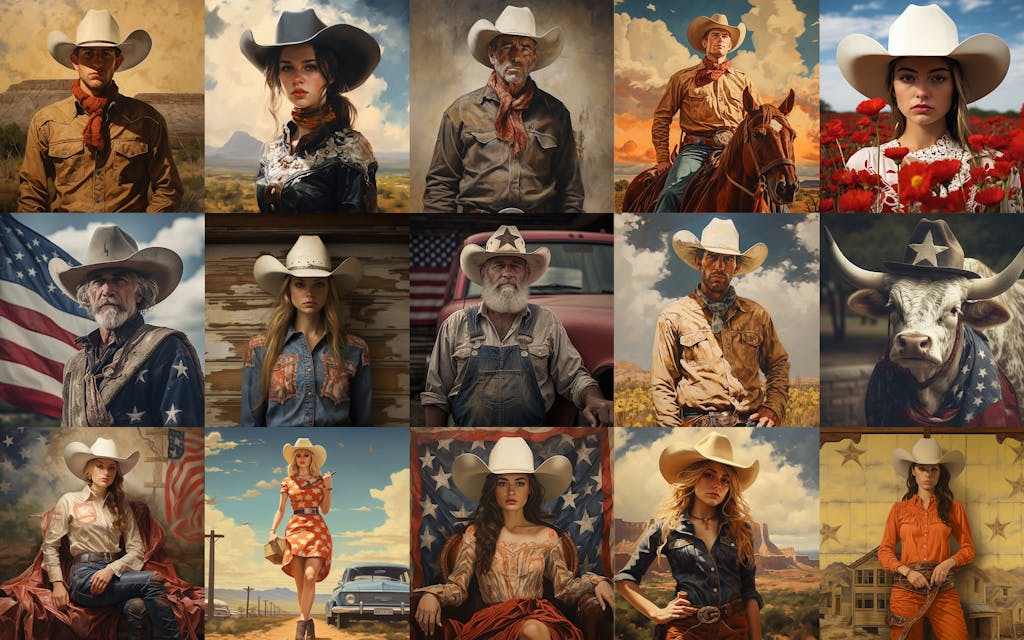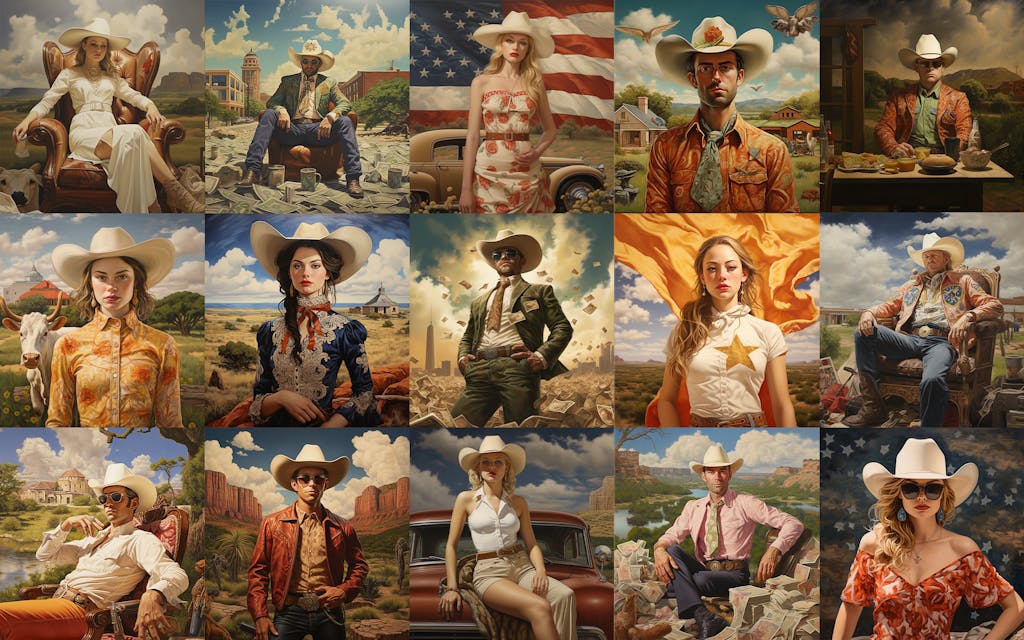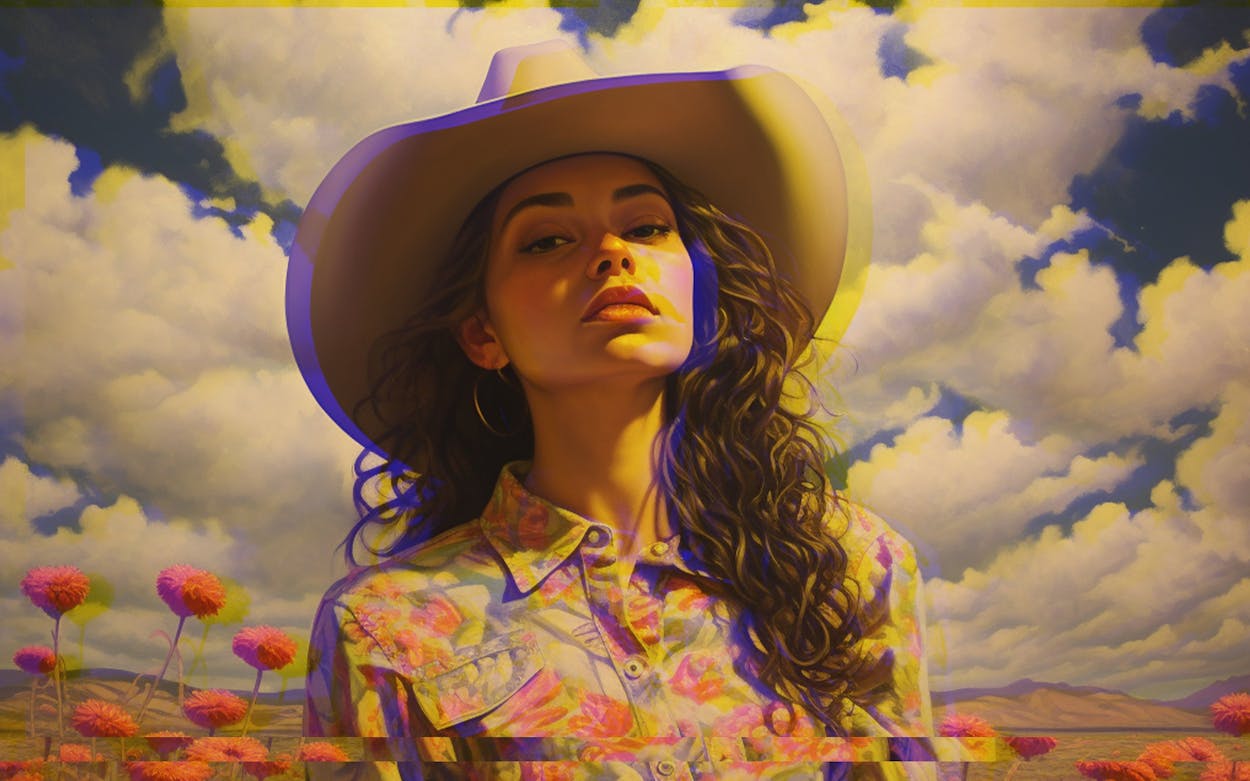Quick: imagine a Texan. If you thought of a rugged white guy in a cowboy hat, artificial intelligence agrees with you—almost.
Inspired by a Rest of World story that examined cultural stereotypes in the popular AI image generator Midjourney, we asked the program to create one hundred images in response to various Texas-related prompts, such as “a Texan,” “a house in Texas,” and “a plate of Texan food.” Of the 100 individuals Midjourney spat out in response to “a Texan,” 92 wore cowboy hats. Five sported other types of hats (three of which looked merely like cowboy hats gone wrong), and only 3 were hatless. Surprisingly, women were the majority—the prompt returned images of 63 women, 36 men, and one cow (wearing, of course, a cowboy hat).

The cowboy hats are no surprise—they’re shorthand for rugged individualism and Texanness (just ask Elon Musk and Jeff Bezos). Although the Stetson was originally manufactured in Philadelphia, countless nineteenth-century trail drives through the state perpetuated the legend of the Texas cowboy. The Texas Rangers and the many onscreen lives of the Lone Ranger ultimately helped cement the association of cowboys and cowboy hats with Texas. But the hats Midjourney generated were often exaggerated and cartoonish. In an apparent reflection of fashion trends prevalent on social media, most of the women looked like they had let “Big Dumb Hat” happen to them. (AI image generators like Midjourney learn from massive datasets of captioned images pulled from all over the internet. The company did not respond to inquiries from Texas Monthly about the details of its program or the images discussed in this article.)
The one hundred AI-generated Texans mostly wore Western-style clothing and stood in front of sweeping West Texas and Panhandle vistas, making them seem like relics of the past. Perhaps surprisingly, cowboy boots were largely absent from the results, as Midjourney primarily produced images from the waist up. Some of the individuals stood in front of American flags, but Midjourney does not appear to know the Texas flag. When asked to generate one in isolation, the program, which produces four images in response to every prompt, came up with one American flag and three valiant efforts involving red, white, and blue.

When it comes to gender and race, the results are almost disturbingly reductive. A female Texan, according to Midjourney, is a very specific type of person. All of the women the program created in response to “a Texan” looked to be between their teens and thirties, except one who was possibly in her forties. (The men showed more age variation, likely because of the prevalence of older and middle-aged ranchers in popular media.) Close to 60 percent of the women appeared to be blond, and many had very pale skin. That could be a reflection of the many blond, light-skinned influencers—not to mention last summer’s silver screen cowgirl Barbie— whose photos proliferate on the internet. But Midjourney learns not just from images people have posted online, says Kory Bieg, a University of Texas architecture professor and AI art expert. The program also tailors its results based on which of each prompt’s four images users choose to download or edit. Regarding the blond cowgirls, “I think so many people are probably looking for those results, and choosing those results, that it sort of understood those to be the results people want,” Bieg says. “It’s partially a bias of the tagging of images, but it’s also bias within us.”
Researchers have proposed mitigating image-creation bias by diversifying underlying datasets, changing how captions are constructed, and altering image-generating algorithms, though it’s not clear what steps Midjourney or other AI platforms are taking. OpenAI, the developer of image generator DALL-E, told the New York Times in July that bias was an “industrywide problem” that OpenAI was working to fix in its programs, though it declined to say how much money or how many employees it had devoted to the issue.
Different races, ethnicities, and body types were notably absent from Midjourney’s vision of a Texan. According to the U.S. Census, 40 percent of Texas residents are Hispanic or Latino (though many of those also identify as white). Texas has been a majority-minority state since 2004, and Hispanics are expected to make up more than 50 percent of the state’s population by the 2040s. Yet only two or three of the hundred AI Texans seemed clearly identifiable as Hispanic. And although Texas has an obesity rate of roughly 36 percent, almost all of the faux Texans (including the cow) were slim.

Bias extended to the results for “a rich Texan” and “a poor Texan,” though in subtler ways. According to Midjourney, most rich Texans are white—but so are most poor ones. The program denoted wealth or poverty mainly with props and body language: Rich Texans were often seated in large leather chairs and had open, relaxed postures. Some posed in front of cars, which, for some reason, were usually red and vintage. Poor Texans, on the other hand, often sat on humble objects like crates or stools and exhibited closed body language, with their arms crossed in front of them. They were frequently surrounded by clutter—sometimes with what appeared to be bottles of hooch—and many were looking down.

Perhaps unsurprisingly, given the proliferation of photos of Texas-style barbecue trays across the internet, one hundred iterations of the prompt “a plate of Texan food” yielded mostly platters of ribs, brisket, and sausage. (Midjourney acknowledged Texas’s vast Mexican and Tex-Mex food lexicon by throwing a few pickled jalapeños on the platters.) Unadorned corn—either on the cob or in a cup—was a popular side, which Texas Monthly barbecue editor Daniel Vaughn says he finds close, but not quite right. “We have a lot of corn in Texas barbecue,” he says, “but it usually is a side of elotes, or creamed corn, corn pudding, things like that.” Of one typical AI platter, featuring ribs, sausage, brisket, pinto beans, and a side of barbecue sauce, he says, “It looks like what a corporate restaurant would do when they introduce their barbecue menu. . . . You know, a place that doesn’t specialize in barbecue, but, ‘Hey, this is what barbecue should look like, we think.’ ”


Practically speaking, advertisers or artists who want to use Midjourney to generate Texan images can choose to avoid certain tropes by writing more-specific prompts. But when it comes to the beloved cowboy hat, the bot clings stubbornly to the cliché. The prompt “a Texan without a cowboy hat” nevertheless yielded four Texans wearing, well, cowboy hats. Ditto for “a Texan not wearing a cowboy hat,” “a hatless Texan,” “a Texan with no hat,” and “a bareheaded Texan”—though that last one did produce a bare-chested Texan.
In June, researchers using Stable Diffusion, a similar AI image generator, found that the prompt “a poor white person” yielded numerous images of Black people, suggesting that certain adjectives carry more weight than others. Midjourney, Bieg says, is geared toward realism, which means it sometimes ignores part of a prompt: “If you put even more words in, it’ll ignore half of them . . . because it’s trying to give you a realistic image.” In the case of two unrelated or opposing words, “if there aren’t a lot of pictures of those two things, it might just pick the one there is more of, hoping that you’ll be satisfied with that more realistic result.”
In other words, AI seems unable to conceive of Texanness without the cowboy hat. As author James Michener reportedly said—or maybe it was Midjourney—“First buy a cowboy hat and boots. Then you’re on your way to being a Texan.”
- More About:
- Art






